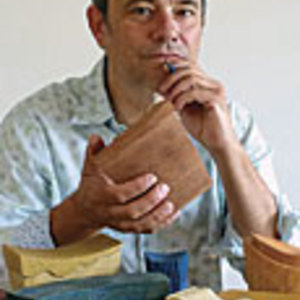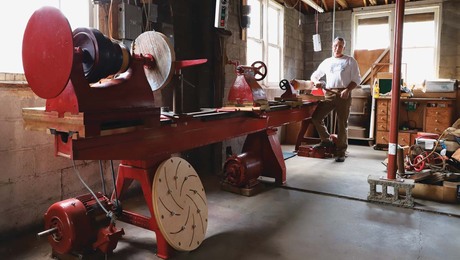Inheritance
When I got home and unpacked the tools at my workshop I discovered that some of them were marked “JFC”—my grandfather’s initials—while others carried a lone “C” on the casting
A few years ago, while driving home to California from the East Coast, I decided on the spur of the moment to take a detour and head north to Pocatello, Idaho, where I was born and where three generations of Cullens lived before me. Essentially, I would be following the Oregon Trail, the very route my ancestors took by wagon and on foot when they arrived in Idaho in the 1850s.
This photograph, taken in Pocatello around 1912, shows my great-grandfather, James Cullen Sr., with two of his sons. In his mid-40s at the time, he was the father of nine children and an accomplished woodworker. His son James, my grandfather (at right in photo), followed him into woodworking, beginning an apprenticeship at age 16 in carpentry and cabinetmaking with the Northern Pacific Railroad in Idaho. He would go on to work for them for 49 years, building everything from train stations to trestle bridges, cabinetry to simple furniture.
During the long, dry, Idaho summers, my grandfather would build houses for extra money. He built a house for his own family in Pocatello, and as a child I was lucky enough to see him work at his bench in the basement. When I was 9, he showed me how to make a mount for the pair of deer antlers I had bought earlier that summer at Yellowstone. He began by tacking two brads, separated by a few inches, into the back of a rectangular piece of walnut. Then he fashioned a loop from a section of string. Without saying a word, he fitted the loop over the brads and drew it tight with a pencil; carefully, in a planetary motion, he traced out a perfect ellipse onto the walnut blank. For me, it was like witnessing magic, and at that moment, still unknown to both of us, I became a woodworker.
During my recent visit to Pocatello I stayed with a cousin whom I hadn’t seen in a decade, and of course we talked all about the family. One morning he led me to a closet under the stairs and opened it to show me an amazing collection of our grandfather’s tools. My cousin isn’t a woodworker, but he clearly respected the tools—they were all carefully separated and placed on shelves, all their parts intact and without a speck of rust anywhere. He had rescued them from our grandfather’s workshop after his death in 1987 and stored them safely for all these years. As we looked through the tools together, I described how each one worked and we traded stories back and forth about our grandfather.
Then my cousin spontaneously broke in and said, “You should have these tools—I know you will use them and care for them.” I was floored, to say the least. I found it difficult to respond; I was astonished by his generosity and just never expected to have such a treasure come my way.
When I got home and unpacked the tools at my workshop I discovered that some of them were marked “JFC”—my grandfather’s initials—while others carried a lone “C” on the casting. Further inspection revealed that all the tools with “C” were from the turn of the 20th century or before. These must originally have belonged to my great-grandfather and been handed down to his son in the 1920s. Now, nearly a century later, they were being handed down again, this time to his great-grandson.
These tools along with all the others I have collected over my career are now housed together in a chest I made long ago. It’s impossible not to favor the tools of my ancestors, and to think as I use them about holding the same plane as they did, for the same purpose, and the same livelihood. And every so often I think perhaps it’s time to buy a set of letter punches so I can add “MC” alongside their initials. Maybe, somewhere down the line, another maker will ask, “MC—I wonder where he fits in with C and JFC?”
Michael Cullen has been making custom furniture in Petaluma,Calif., since 1990. Send your woodworking story to bench@taunton.com; we’ll pay for any that we publish.
More from Michael on FineWoodworking.com:
- Fundamentals: How to frame a picture – What you need—and need to know— once you’ve built the picture frame
- Enter the octagon – Old-world exercise hones hand-tool skills
- Accentuate Carving with Color – Creative use of milk paint gives textured surfaces
Fine Woodworking Recommended Products

Stanley Powerlock 16-ft. tape measure

Veritas Micro-Adjust Wheel Marking Gauge

Veritas Precision Square



























Comments
Beautiful storytelling Michael! I'd love to see a picture or two of the most cherished tools. I have a similar collection which I use on certain projects.
What a great story!
Thanks for publishing it for the rest of us.
Yes, it is cruel and unusual punishment not to include photos of your grandfather's tools! Please do so, and point out the ones you continue to use. Thank you for sharing such a great family story.
Brought a tear to my eye ( not afraid to say ) and yes no photo's makes it a great mystery. But good on ya and glad you got them.
Excellent story. Nice to have tools with personal meaning. Every old tool begs to imagine its history and who may have used it and for what. Lovely to have some where you know a part of their story. Blessings.
Log in or create an account to post a comment.
Sign up Log in